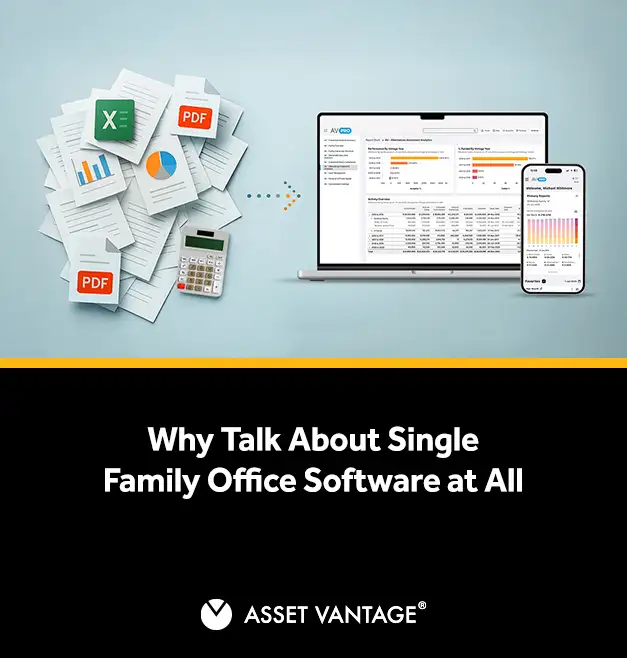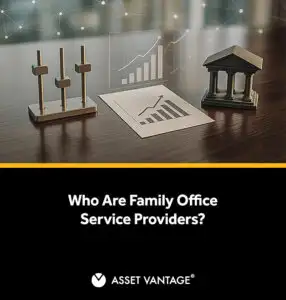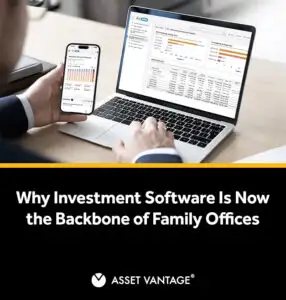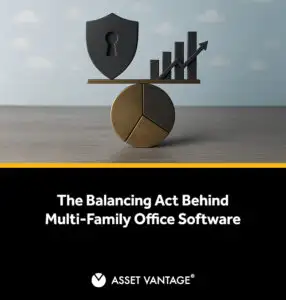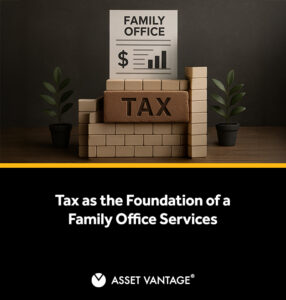Read Time16 Mins
- Why Talk About Single Family Office Software at All
- Why Families Need Purpose-Built Tools
- Single-Family Offices vs Multi-Family Offices
- Core Features of Single Family Office Software
- Investment Management Requirements
- Wealth Management And Reporting Functions
- Risk, Privacy, and Control
- Wealth Management And Reporting Functions
- How to Choose the Right Single Family Office Software
- Decision-Making Triggers for Single Family Offices
Why Talk About Single Family Office Software at All
- Privacy risks: Private data scattered across files and emails.
- Accuracy gaps: Manual updates miss capital calls or delayed valuations.
- Complexity limits: Assets held within multiple trusts, entities, and asset classes strain Excel’s capabilities.
- Weak governance: Fragmented and inconsistent reporting erodes confidence in oversight.
What Is Single Family Office Software
Single-family office software is a purpose-built platform that manages family wealth, private data, investment portfolios, and financial activities. It integrates family office general ledger accounting, consolidated reporting across multiple entities, and performance analysis across multiple asset classes.
Unlike basic portfolio tools, these platforms provide investment analytics, and automated data feeds from custodians and investment firms. This enables families to track private equity holdings, real estate, and alternative assets with precision, rather than relying on manual updates.
How Single Family Office Software Differs From Multi-Family Office Platforms
- Privacy and control: Sensitive data stays within one family’s environment.
- Customised reporting: Each family member can view reports relevant to their role in governance.
- Complexity management: From private assets to illiquid investments, data aggregation reflects the family’s unique portfolio.
Who Uses Single Family Office Software
Single-family office software serves a wide range of stakeholders inside and around the family office:
- Wealth owners who want seamless access to portfolio data and accurate performance reporting.
- Business managers who oversee document management, compliance, and daily family office operations.
- Family office professionals and investment managers who run investment data aggregation, asset allocation, and portfolio analysis.
- Financial advisors who provide a strategy need reliable financial data.
| Criteria | Spreadsheets / Generic Wealth Tools | Single Family Office Software |
|---|---|---|
| Privacy | Limited controls, risk of shared files | Role-based access, audit trails, secure private data |
| Reporting | Manual, prone to error | Customized reporting for family members, accurate performance reporting |
| Data Aggregation | Manual data handling, inconsistent formats | Automated data feeds from custodians, investment firms, and asset managers |
| Complexity | Breaks down with complex wealth structures | Handles multiple trusts, entities, and alternative assets |
| Governance | No link to family governance or succession | Supports governance frameworks and generational planning |
| Continuity | Dependent on individual business managers | Captures workflows, reduces key-person risk |
Why Families Need Purpose-Built Tools
Why Manual Data Handling Fails Single Family Offices
- Accuracy: Errors multiply as data is copied between files.
- Privacy: Sensitive wealth data is scattered without audit trails.
- Oversight: Reports cannot withstand regulatory or governance review.
How Private Assets And Illiquid Assets Create Complexity
When Spreadsheets No Longer Work For Family Wealth Management
- Complexity: Multiple trusts, entities, and asset classes stretch spreadsheets until errors inevitably creep in. Families end up with reports that never reconcile across entities. Late capital call notices and manual restatements create inconsistencies across periods, undermining confidence in the numbers.
- Privacy: Private data is spread across unsecured files without audit trails. Sensitive wealth data leaks into emails and cannot be defended in an audit.
- Continuity: Operations depend on one or two business managers holding critical knowledge. Turnover or absence means reporting stops, and memory gaps appear.
- Compliance: Spreadsheets cannot create defensible records for regulatory reviews or tax audits. Tax audits expose inconsistencies that weaken credibility.
- Reporting: Family members receive inconsistent updates, eroding trust in governance. Numbers change between reports, leading to disputes in meetings.
What Software Delivers Instead
- Customised reporting: Parents track asset allocation, the next generation sees simplified dashboards to learn, and advisors review detailed portfolio analytics. Each view is built from the same data, avoiding conflicting versions.
- Operational continuity: Workflows are captured in the system. Even if a business manager leaves or a transaction is back-dated, reporting continues without gaps or memory loss.
- Regulatory readiness: Audit trails and compliance-grade records withstand tax audits and cross-border reviews. Families avoid last-minute reconciliations that undermine credibility.
- Advisor enablement: Wealth managers and financial advisors rely on accurate feeds instead of fixing spreadsheets. Time shifts from reconciliations to investment strategy, governance, and client service.
Who Uses Single Family Office Software
Single-family office software serves a wide range of stakeholders inside and around the family office:
- Wealth owners who want seamless access to portfolio data and accurate performance reporting.
- Business managers who oversee document management, compliance, and daily family office operations.
- Family office professionals and investment managers who run investment data aggregation, asset allocation, and portfolio analysis.
- Financial advisors who provide a strategy need reliable financial data.
| Criteria | Manual Spreadsheets / Generic Tools | Single Family Office Software |
|---|---|---|
| Accuracy | Prone to errors and inconsistent formulas | Automated reconciliations and accurate reporting |
| Investment Data | Fragmented across custodians and emails | Investment data aggregation across asset classes and custodians |
| Complexity | Breaks under multi-asset portfolios and complex partnership structures | Handles trusts, entities, and complex wealth structures with ease |
| Privacy | Limited access controls; data often shared insecurely | Private data safeguarded with audit trails and role-based permissions |
| Performance Reporting | Manual updates delay insights and reviews | Real-time portfolio analytics and investment performance dashboards |
| Continuity | Dependent on one or two individuals | Captures workflows and reduces key-person risk |
Single-Family Offices vs Multi-Family Offices
Different Mandates And Governance Between Single And Multi-Family Offices
- Single-family offices need privacy controls, customised reporting, and governance tools that reflect one family’s values.
- Multi-family offices need scalability, standardised templates, and efficiency across diverse clients.
Why Single Family Office Software Requirements Differ From Multi-Family Office Systems
- Single-family offices need integrated platforms for private equity, alternative investments, and consolidated reporting across complex wealth structures.
- Multi-family offices need scalable systems that standardise reporting and deliver efficiency across multiple clients.
Comparison: Single Family Office Software Vs Multi Family Office Software
| Criteria | Single Family Office Software | Multi-Family Office Software |
|---|---|---|
| Privacy & Control | High, with private data and family values protected | Shared systems, less granular privacy |
| Reporting | Customised reporting for family members | Standardised reports across clients |
| Investment Data | Focus on private assets and alternative investments | Broader aggregation across asset classes |
| Governance | Tailored to family dynamics and succession planning | More institutional and process-driven |
| Scalability | Depth over breadth, built for one family | Breadth over depth, optimised for multiple families |
Core Features of Single Family Office Software
Family Office Accounting Software And Management Tools
- Accuracy: Every entry ties back to a single ledger, improving trust in financial data.
- Compliance: Tax filings and audits rely on consistent, defensible records.
- Continuity: Teams avoid dependency on individual memory or siloed files.
Investment Data Aggregation Across Asset Classes
- Consolidation: All holdings, public and private, sit in one view.
- Transparency: No asset class is hidden or under-reported.
- Timeliness: Data arrives faster, enabling genuine investment analytics.
Document Management And Compliance Functionality
- Security: Sensitive records remain protected from leaks or loss.
- Efficiency: Files can be retrieved instantly rather than searched across silos.
- Audit readiness: Families face regulatory reviews with confidence.
Governance And Succession Planning Modules
- Governance: Decision-making becomes transparent and consistent.
- Succession: Heirs learn to oversee assets before they inherit control.
- Continuity: Family values remain present in wealth management across generations.
Investment Management Requirements
It is about ensuring that every investment, whether liquid or illiquid, is measured, reported, and aligned with family goals. Software becomes essential because private equity, alternative assets, and complex allocations cannot be tracked reliably with spreadsheets.
How Family Offices Track Private Equity Holdings
Supporting Alternative Investments And Private Assets
Asset Allocation And Portfolio Management In One Family Office
Integrating Advisors, Asset Managers, And Reporting Platforms
Software integrates these stakeholders into one platform. Advisors, managers, and business managers all view the same consolidated reports. Automated feeds replace manual reconciliations, and families retain control over data while benefiting from professional expertise.
Operator Reality: Excel vs Software for Private Equity Tracking
| Task | Excel | Single-Family Office Software |
|---|---|---|
| Track commitments | Manual updates are prone to missed entries | Automated feeds with alerts |
| Handle late valuations | Restates past reports, erodes trust | Posts adjustments transparently, preserves history |
| View exposures | Fragmented across funds and formats | Consolidated portfolio analytics |
Wealth Management And Reporting Functions
Consolidated Reporting For Family Wealth Structures
- Integration: All asset classes and ownership entities are brought into one reporting platform.
- Transparency: Families gain a full view of wealth across structures.
- Oversight: Decision-makers evaluate exposure and cash flow in context.
Customised Reporting For Family Members And Wealth Owners
- Parents: Track asset allocation and long-term investment performance.
- Next generation: Learn about alternative investments and portfolio composition.
- Trustees or advisors: Access deeper reports for compliance and strategic planning.
Seamless Access To Portfolio Data For Financial Advisors
- Accuracy: Data is automatically updated, reducing reliance on manual spreadsheets.
- Collaboration: Advisors access the same system used by the family office team.
- Efficiency: Strategy discussions are based on current numbers, not outdated rep
With seamless access, advisors shift from data validation to strategic guidance, delivering more value to the family.
Accurate Performance Reporting For Investment Portfolio Analysis
- Comparability: Returns across public markets and private equity are measured consistently.
- Accuracy: Data reconciles back to custodians and investment firms.
- Decision support: Families evaluate whether strategies are meeting long-term goals.
Risk, Privacy, and Control
Protecting Private Data In Modern Family Offices
- Access control: Only authorised family office professionals can view or edit specific records.
- Audit trails: Every change is recorded, creating defensible evidence for compliance.
- Cybersecurity: Data is encrypted and monitored against breaches.
Reducing Operational Inefficiency Through Automation
- Error reduction: Automated processes minimise mistakes in investment and financial data.
- Efficiency: Staff can shift from manual reconciliations to client service and governance.
- Continuity: Automated workflows preserve knowledge, reducing key-person risk.
Ensuring Compliance And Regulatory Readiness
- Regulatory alignment: Transactions and reports follow tax and accounting standards..
- Audit readiness: Records are structured to withstand external review.
- Risk management: Compliance features reduce the chance of penalties or disputes.
How to Choose the Right Single Family Office Software
Evaluating Privacy And Control In One Family Office
- Cybersecurity: Protects against external breaches and insider misuse.
- Audit trails: Record every change, strengthening compliance and reporting platforms.
- Control: Operators define permissions so family members see only what they need.
Balancing Scalability With Simplicity In Family Office Operations
- Multi-asset portfolios: Equity, bonds, private equity, and alternative investments consolidated in one view.
- Wealth data complexity: Structures across entities and geographies are tracked without manual work.
- Usability: Reports refreshed by business managers, not by external consultants.
Managing complexity in family wealth structures
- Partnership structures: Trusts, holding companies, and joint ventures are mapped accurately.
- Consolidated reporting: Investment data from all sources aggregated for oversight.
- Portfolio analytics: Performance measured across both liquid and illiquid assets.
Decision-Making Triggers for Single Family Offices
The risks of the wrong system vs the clarity of the right one
The difference between the wrong and right system is the difference between
confusion and clarity in every decision.
When to move from Excel to single-family office software
back-dated transactions enter, only purpose-built software provides reliable
reporting.
Costs of delaying adoption in one family office
inefficiency weakens confidence and reduces the value of governance.
How service providers support single-family office operations
- Support for business managers: External teams reduce dependency on one or two staff.
- Consistency: Reports are delivered on schedule regardless of staffing changes.
- Expertise: Providers familiar with private equity firms and alternative assets help normalise inconsistent data feeds and standardise valuations.
| Trigger | What It Looks Like | Why It Matters |
|---|---|---|
| Fragmented financial data | Multiple spreadsheets across trusts, entities, and custodians that never reconcile cleanly | Creates blind spots, errors, and inconsistent reporting across the family office |
| Complex portfolios | Capital calls, distributions, and valuation updates from private equity firms and alternative assets | Excel cannot accurately restate prior periods, leading to inconsistencies in historical reports and a loss of confidence. |
| Inefficiency costs | Business managers are spending hours on reconciliations instead of oversight | Time lost to manual fixes prevents timely analysis and strategic reporting |
| Delayed adoption | Staying on spreadsheets despite growing wealth structures | Increases operational risk, exposes compliance gaps, and hides portfolio risks until too late |
| Need for external support | Service providers asked to patch reporting gaps manually | Adds cost without solving root problems, and reduces control over sensitive data |

